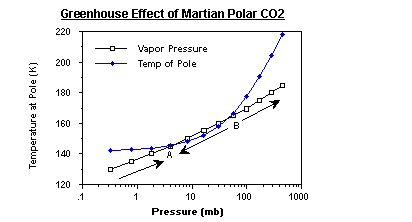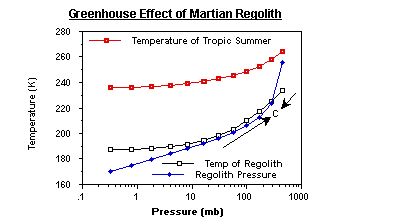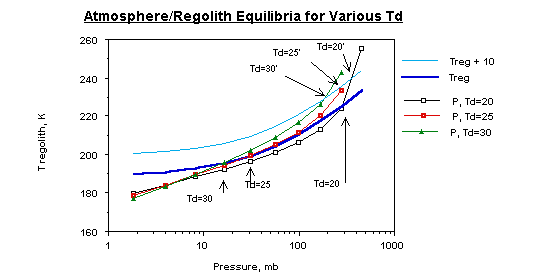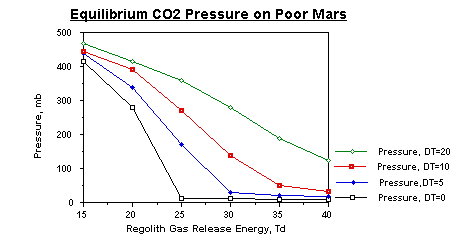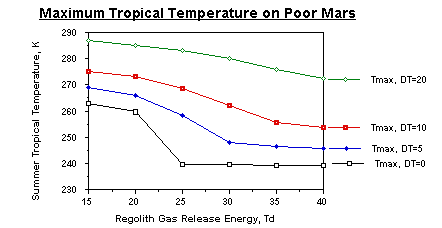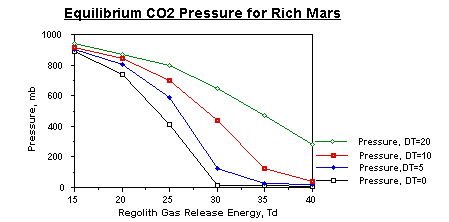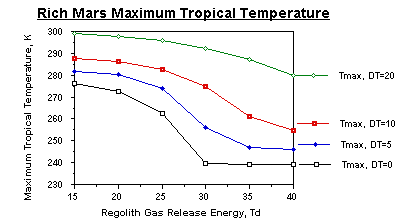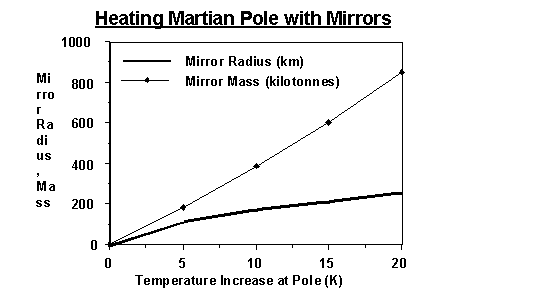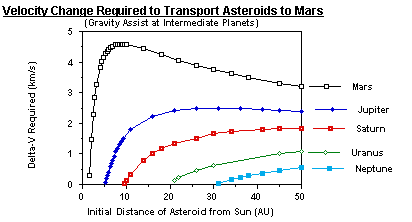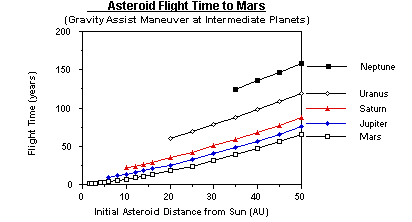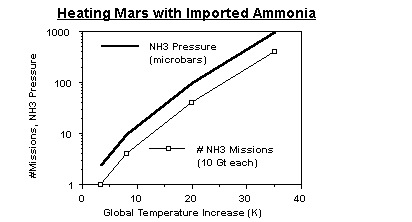|
|
|
Pioneer Astronautics and NASA Ames Research Center
It is believed, however, that sufficient CO2 to form a 300 to 600 mb atmosphere may still exist in volatile form, either adsorbed into the regolith or frozen out at the south pole. This CO2 may be released by planetary warming, and as the CO2 atmosphere thickens, positive feedback is produced which can accelerate the warming trend.
Thus it is
conceivable, that by taking advantage of the positive feedback
inherent in Mars' atmosphere/regolith CO2 system, that engineering
efforts can produce drastic changes in climate and pressure on a
planetary scale.
We examine the potential
of various schemes for producing the initial warming to drive the
process, including the stationing of orbiting mirrors, the
importation of natural volatiles with high greenhouse capacity from
the outer solar system, and the production of artificial halocarbon
greenhouse gases on the Martian surface through in-situ industry.
If
manufactured in space out of asteroidal or Martian moon material,
about 120 MWe-years of energy would be needed to produce the
required aluminum. This amount of power can be provided by near-term
multi-megawatt nuclear power units, such as the 5 MWe modules now
under consideration for NEP spacecraft.
If the asteroid is made of NH3, specific impulses
of about 400 s can be attained, and as little as 10% of the asteroid
will be required for propellant. Four 5000 MWt NTR engines would
require a 10 year burn time to push a 10 billion tonne asteroid
through a DV of 300 m/s. About 4 such objects would be sufficient to
greenhouse Mars.
With outside atmospheric pressures raised, it will be possible to create large dwelling areas by means of very large inflatable structures. Average temperatures could be above the freezing point of water for significant regions during portions of the year, enabling the growth of plant life in the open. The spread of plants could produce enough oxygen to make Mars habitable for animals in several millennia.
More
rapid oxygenation would require engineering efforts supported by
multi-terrawatt power sources. It is speculated that the desire to
speed the terraforming of Mars will be a driver for developing such
technologies, which in turn will define a leap in human power over
nature as dramatic as that which accompanied the creation of
post-Renaissance industrial civilization.
The essence of the situation is that while Mars' CO2 atmosphere has only about 1% the pressure of the Earth's at sea level, it is believed that there are reserves of CO2 frozen in the south polar cap and adsorbed within the soil sufficient to thicken the atmosphere to the point where its pressure would be about 30% that of Earth.
The way to get this gas to emerge is to heat the
planet, and in fact, the warming and cooling of Mars that occurs
each Martian year as the planet cycles between its nearest and
furthest positions from the Sun in its slightly elliptical orbit
cause the atmospheric pressure on Mars to vary by plus or minus 25%
compared to its average value on a seasonal basis.
Such an atmospheric greenhouse could be created on Mars in at least three different ways. One way would be to set up factories on Mars to produce very powerful artificial greenhouse gasses such as halocarbons ("CFC's") and release them into the atmosphere. Another way would be to use orbital mirrors or other large scale power sources to warm selected areas of the planet, such as the south polar cap, to release large reservoirs of the native greenhouse gas, CO2, which may be trapped their in frozen or adsorbed form.
Finally
natural greenhouse gases more powerful than CO2 (but much less so
than halocarbons) such as ammonia or methane could be imported to
Mars in large quantities if asteroidal objects rich with such
volatiles in frozen form should prove to exist in the outer solar
system.
A method of modeling this system and the results of
calculations based upon it are given in the sections below.
Since the atmosphere is an effective means of heat transport from the equator to the pole,we propose (as an improvement over equation (1) in reference [2]:
For purposes of this analysis it is further assumed based upon a rough approximation to observed data that:
and that the global temperature distribution is given by:
Equations (1) through (4) given the temperature on Mars as a function of CO2 pressure.
However, as mentioned above, the CO2 pressure on Mars is itself a function of the temperature. There are three reservoirs of CO2 on Mars, the atmosphere, the dry ice in the polar caps, and gas adsorbed in the soil. the interaction of the polar cap reservoirs with the atmosphere is well understood and is given simply by the relationship between the vapor pressure of CO2 and the temperature at the poles.
This is given by the vapor pressure curve for CO2, which is approximated by:
So long as there is CO2 in both the atmosphere and the cap, equation (5) gives an exact answer to what the CO2 atmospheric pressure will be as a function of polar temperature.
However if the polar
temperature should rise to a point where the vapor pressure is much
greater than that which can be produced by the mass in the cap
reservoir (between 50 and 150 mb) then the cap will disappear and
the atmosphere will be regulated by the soil reservoir.
Equation (6) is essentially a variation on Van Hofft's law for the change in chemical equilibrium with temperature, and so there is fair confidence that its general form is correct.
However the value of Td is unknown and probably will remain so until after human exploration of Mars. In reference [2] McKay et al varied parametrically Td from 10 to 60 K and produced curves using equation (6) with T set equal to either Tpole or Tmean. In this paper we choose Td=15 to 40 K (a reasonable subset of the spectrum slightly on the optimistic side; the lower the value of Td the easier things are for prospective terraformers.)
Because equation (6) is so strongly temperature dependent, however, we do not simply set T to the extreme values of Tmean or Tpole and solve equation (6) to get a global "soil pressure" however, as was done in reference [2]. Rather we use the global temperature distribution given by equation (4) to integrate equation (6) over the surface of the planet.
This gives a more accurate quasi 2-Dimensional view of the atmosphere/regolith equilibrium problem in which most of the adsorbed CO2 is distributed to the planet's colder regions.
In this model, regional (in the
sense of latitude) temperature changes, especially in the near-polar
regions, can have as important a bearing on the atmosphere/regolith
interaction as changes in the planet's mean temperature.
There are two equilibrium points, labeled A and B where the values of P and T are mutually consistent. However A is a stable equilibrium, while B is unstable. This can be seen by examining the dynamics of the system wherever the two curves do not coincide. Whenever the temperature curve lies above the vapor pressure curve, the system will move to the right, i.e. towards increased temperature and pressure; this would represent a runaway greenhouse effect.
Whenever the pressure curve lies above the
temperature curve, the system will move to the left, i.e. a
temperatures and pressure will both drop in a runaway icebox icebox
effect. Mars today is at point A, with 6 mbar of pressure and a
temperature of about 147 K at the pole.
If the temperature increase were 4 K, the temperature curve would be moved upwards on the graph sufficiently so that it would lie above the vapor pressure curve everywhere.
Fig. 1 Mars polar cap/atmosphere dynamics. current equilibrium is at point A. Raising polar temperatures by 4 K would drive equilibria A and B together, causing runaway heating that would lead to the elimination of the cap.
Mars regolith/atmosphere dynamics under conditions of Td=20
with a volatile inventory of 500 mb of CO2
The result would be a runaway greenhouse effect that would cause the entire pole to evaporate, perhaps in less than a decade.
Once the pressure and temperature have moved past the
current location point B, Mars will be in a runaway greenhouse
condition even without artificial heating, so if later the heating
activity were discontinued the atmosphere will remain in place.
The
dynamics of this system are shown in fig. 2, in which we assume
Td=20, current polar reserves of 100 mb, and regolith reserves of
394 mb, and graph the pressure on the planet as a function of Treg,
where Treg is the weighted average of the temperature given by
integrating the right hand side of equation (6) over the surface of
the planet using the temperature distribution given by equation (4).
Since Treg is a function of the temperature distribution and Tmean,
it is a function of P, and thus Treg(P) can also be graphed. The
result are a set of T(P) curves and P(T) curves, whose crossing
points reflect stable or unstable equilibrium, just as in the case
of the polar cap analysis.
Also shown in
Fig. 2 is the day-night average temperature that will result in
Mars' tropical regions (Tmax) during summertime. It can be seen that
the 273 K freezing point of water will be approached. With the
addition of modest ongoing artificial greenhouse efforts, it can be
exceeded.
Such extraordinary sensitivity of the final condition to the unknown value of Td may appear at first glance to put the entire viability of the terraforming concept at risk. However in fig 3 we also show (dotted line) the situation if artificial greenhouse methods are employed to maintain Treg at a temperature 10 K above those produced by the CO2 outgassing itself.
It can be seen that drastic improvements in the final T and P values are effected for the Td=25 and 30 cases, with all three cases converging upon final states with Mars possessing atmospheres with several hundred millibars pressure.
Fig. 3 An induced 10 K rise in regolith temperature can counter effect of Td variations. Data shown assumes a planetary volatile inventory of 500 mb CO2.
In figs 4,5,6, and 7 we show the convergence condition pressure and maximum seasonal average temperature in the Martian tropics resulting on either a "poor" Mars, possessing a total supply of 500 mb of CO2 (50 mb of CO2 in the polar cap and 444 mb in the regolith), or a "rich" Mars possessing 1000 mb of CO2 (100 mb in the polar cap and 894 mb in the regolith).
Different curves are shown under the assumptions that either no sustained greenhouse effort is mounted after the initial polar cap release, or that continued efforts are employed to maintain the planet's mean temperature 5, 10 or 20 degrees above the value produced by the CO2 atmosphere alone.
It can be seen that if a sustained effort is mounted to keep an artificial DT of 20 degrees in place, then a tangible atmosphere and acceptable pressures can be produced even if Td has a pessimistic value of 40 K.
Fig .4 Equilibrium pressure reached on Mars with a planetary volatile inventory of 500 mb CO2 after 50 mb polar cap has been evaporated. DT is artificially imposed sustained temperature rise.
Equilibrium maximum seasonal (diurnal average) temperature reached on Mars with a planetary volatile inventory of 500 mb CO2 after 50 mb polar cap has been evaporated
Equilibrium pressure reached on Mars with a planetary volatile inventory of 1000 mb CO2 after 100 mb polar cap has been evaporated
Equilibrium maximum seasonal temperature (diurnal average) reached on Mars with a planetary volatile inventory of 1000 mb CO2 after 100 mb polar cap has been evaporated.
The important conclusion to be drawn from this analysis is that while the final conditions on a terraformed Mars may be highly sensitive to the currently unknown value of the regoliths outgassing energy, Td, they are even more sensitive to the level of sustained artificially induced greenhousing, DT.
Put simply, the final
conditions of the atmosphere/regolith system on a terraformed Mars
are controllable.
Water vapor is also a very effective greenhouse gas, and since the vapor pressure of water on Mars would rise enormously under such circumstances, the reappearance of liquid water on the Martian surface would add to the avalanche of self accelerating effects all contributing towards the rapid warming of Mars.
The seasonal availability of liquid water is
also the key factor in allowing the establishment of natural
ecosystems on the surface of Mars.
Nevertheless, it is clear that the positive feedback generated by the Martian CO2 greenhouse system greatly reduces the amount of engineering effort that would otherwise be required to transform the Red Planet. In fact, since the amount of a greenhouse gas needed to heat a planet is roughly proportional to the square of the temperature change required, driving Mars into a runaway greenhouse with an artificial 4 K temperature rise only requires about 1/200th the engineering effort that would be needed if the entire 55 K rise had to be engineered by brute force.
The question we shall now examine is how such a 4 K
global temperature rise could be induced.
We discuss each of these in turn. It should be
noted, however, that synergistic combination of several such methods
may yield better results than any one of them used alone [4].
A much more practical idea would be to construct a more modest mirror capable of warming a limited area of Mars by a few degrees.
As shown by the data in fig. 1, a 5 degree K temperature rise imposed at the pole should be sufficient to cause the evaporation of the CO2 reservoir in the south polar cap. Based upon the total amount of solar energy required to raise the black-body temperature a given area a certain number of degrees above the polar value of 150 K, we find that a space-based mirror with a radius of 125 km could reflect enough sunlight to raise the entire area south of 70 degrees south latitude by 5 K.
If made of solar sail type aluminized mylar material with a density of 4 tonnes/km^2, such a sail would have a mass of 200,000 tonnes. This is too large to consider launching from Earth, however if space-based manufacturing techniques are available, its constructing in space out of asteroidal or Martian moon material is a serious option.
The total amount of energy required to process. the materials for such a reflector would be about 120 MWe-years, which could be readily provided by a set of 5 MWe nuclear reactors such as are now being considered for use in piloted nuclear electric spacecraft. Interestingly, if stationed near Mars, such a device would not have to orbit the planet.
Rather, solar light pressure could be made to balance the planet's gravity, allowing it to hover as a "statite" [6] with its power output trained constantly at the polar region. For the sail density assumed, the required operating altitude would be 214,000 km.
The statite reflector concept and the required mirror size to produce a given polar temperature rise is shown in figs 8 and 9.
Fig.8 Solar sails of 4 tonnes/km2 density can be held stationary above Mars by light pressure at an altitude of 214,000 km. Wasting a small amount of light allows shadowing to be avoided.
Solar sail mirrors with radii on the order of 100 km and masses of 200,000 tonnes can produce the 5 K temperature rise required to vaporize the CO2 in Mars' south polar cap.
It may be
possible to construct such mirrors in space.
If the value of Td is lower than 20 K, then the release of the polar CO2 reserves by themselves could be enough to trigger the release of the regolith's reserves in a runaway greenhouse effect.
If however,
as seems probable, Td is greater than 20 K, then either the
importation or production of strong greenhouse gases will be
required to force a global temperature rise sufficient to create a
tangible atmospheric pressure on Mars.
If moving material from such objects to Mars is envisioned, then such orbits would be quite convenient, because strange as it may seem, it is easier to move an asteroid from the outer solar system to Mars than it is to do so from the Main Belt or any other inner solar system orbit. This odd result follows from the laws of orbital mechanics, which cause an object farther away from the Sun to orbit it slower than one that is closer in.
Because an object in the outer solar system moves slower, it takes a smaller DV to change its orbit from a circular to an ellipse. Furthermore, the orbit does not have to be so elliptical that it stretches from Mars to the outer solar system; it is sufficient to distort the objects orbit so that it intersects the path of a major planet, after which a gravity assist can do the rest. The results are shown in Fig. 10.
It can be seen that moving an asteroid positioned in a circular
orbit at 25 AU, by way of a Uranus gravity assist to Mars, requires
a DV of only 0.3 km/s, compared to a 3.0 km/s DV to move an asteroid
directly to Mars from a 2.7 AU position in the Main Belt. the time
of flight required for such transfers is shown in Fig. 11.
In all probability, the outer solar system contains thousands of asteroids that we have yet to discover because they shine so dimly compared to those in the Main Belt (The brightness of an asteroid as seen from Earth is inversely proportional to the fourth power of its distance from the Sun.). Furthermore, because water, ammonia, and other volatiles freeze so completely in the outer solar system, it is likely that the asteroids to be found beyond Saturn are largely composed of frozen gases (such appears to be the case for Chiron).
This makes it
possible for us to move them.
If a quartet of 5000 MW nuclear thermal rocket engines powered by either fission or fusion were used to heat some of its ammonia up to 2200 K (5000 MW fission NTRs operating at 2500 K were tested in the 1960s), they would produce an exhaust velocity of 4 km/s, which would allow them to move the asteroid onto its required course using only 8% of its material as propellant.
Ten years of steady thrusting would be required, followed by a about a 20 year coast to impact. When the object hit Mars, the energy released would be about 10 TW-years, enough to melt 1 trillion tonnes of water (a lake 140 km on a side and 50 meters deep).
In addition, the ammonia released by a single such object would raise the planet's temperature by about 3 degrees centigrade and form a shield that would effectively mask the planet's surface from ultraviolet radiation. As further missions proceeded, the planet's temperature could be increased globally in accord with the data shown in Fig. 12.
Forty such missions would
double the nitrogen content of Mars' atmosphere by direct
importation, and could produce much more if some of the asteroids
were targeted to hit beds of nitrates, which they would volatilize
into nitrogen and oxygen upon impact. If one such mission were
launched per year, within half a century or so most of Mars would
have a temperate climate, and enough water would have been melted to
cover a quarter of the planet with a layer of water 1 m deep.
Moreover, if Td is greater than 20 K, a sustained greenhousing effort will be required. as the characteristic lifetime of an ammonia molecule on Mars is likely to be less than a century, this means that even after the temperature is raised, ammonia objects would need to continue to be imported to Mars, albeit at a reduced rate.
As each object will hit Mars with an
energy yield equal to about 70,000 1 megaton hydrogen bombs, the
continuation of such a program may be incompatible with the
objective of making Mars suitable for human settlement.
Similar schemes might also be feasible for cycling methane, another short-lived natural greenhouse gas which might be imported to the planet.
Fig.10 Using gravity assists, the DV required to propel an outer solar system asteroid onto a collision course with Mars can be less than 0.5 km/s. Such "falling" objects can release much more energy upon impact than was required to set them in motion.
Ballistic flight times from the outer solar system to Mars are typically between 25 and 50 years.
Importing four 10 billion tonne ammonia asteroids to Mars would impose an 8 K temperature rise, which after amplification by CO2 feedback could create drastic changes in global conditions.
If the gases have an atmospheric lifetime of 100 years, then approximately 1/5th the power levels shown in the table will be needed to maintain the CFC concentration after it has been built up. For purposes of comparison, a typical nuclear power plant used on Earth today has a power output of about 1000 MWe. and provides enough energy for a medium sized (Denver) American city.
The industrial effort associated with such a power level would be substantial, producing about a trainload of refined material every day and requiring the support of a work crew of several thousand people on the Martian surface. A total project budget of several hundred billion dollars might well be required.
Nevertheless, all things considered, such an operation is hardly likely to be beyond the capabilities of the mid 21st Century.
Table 1 Greenhousing Mars with CFCs
Humans could not breath the air of the thus transformed Mars, but they would no longer require space suits and instead could travel freely in the open wearing ordinary clothes and a simple SCUBA type breathing gear. However because the outside atmospheric pressure will have been raised to human tolerable levels, it will be possible to have large habitable areas for humans under huge domelike inflatable tents containing breathable air.
On the other hand, simple hardy plants could thrive in the CO2 rich outside environment, and spread rapidly across the planets surface. In the course of centuries, these plants would introduce oxygen into Mars's atmosphere in increasingly breathable quantities, opening up the surface to advanced plants and increasing numbers of animal types.
As this occurred, the CO2 content of the atmosphere would be reduced, which would cause the planet to cool unless artificial greenhouse gases were introduced capable of blocking off those sections of the infrared spectrum previously protected by CO2. The halocarbon gases employed would also have to be varieties lacking in chlorine, if an ultraviolet shielding ozone layer is to be built up.
Providing these
matters are attended to, however, the day would eventually come when
the domed tents would no longer be necessary.
However the oxygen and nitrogen levels in the atmosphere
would be too low for many plants, and if left in this condition the
planet would remain relatively dry, as the warmer temperatures took
centuries to melt Mars' ice and deeply buried permafrost. It is in
this, the second phase of terraforming Mars, during which the
hydrosphere is activated, the atmosphere made breathable for
advanced plants and primitive animals, and the temperature increased
further, that either space based manufacturing of large solar
concentrators or human activity in the outer solar system is likely
to assume an important role.
Each such
impact releases the energy equivalent of 10 TW-yrs. If Plowshare
methods of shock treatment for Mars are desired, then the use of
such projectiles is certainly to be preferred to the alternative
option [4] of detonation of hundreds of thousands of thermonuclear
explosives. After all, even if so much explosive could be
manufactured, its use would leave the planet unacceptably
radioactive.
This is triple the power available from the impact of 1 10 billion tonne asteroid per year, and in all probability would be far more controllable. A single such mirror could drive vast amounts of water out of the permafrost and into the nascent Martian ecosystem very quickly.
Thus while the engineering
of such mirrors may be somewhat grandiose, the benefits to terraforming of being able to wield tens of TW of power in a
controllable way can hardly be overstated.
While Mars may have super-oxides in its soil or nitrates that can be pyrolysed to release oxygen (and nitrogen) gas, the problem is the amount of energy needed: about 2200 TW-years for every mb produced. Similar amounts of energy are required for plants to release oxygen from CO2. Plants, however, offer the advantage that once established they can propagate themselves.
The production of an oxygen atmosphere on Mars thus breaks down into two phases. In the first phase, brute force engineering techniques are employed to produce sufficient oxygen (about 1 mb) to allow advanced plants to propagate across Mars.
Assuming 3 125 km radius space mirrors active in supporting such a program and sufficient supplies of suitable target material on the ground, such a goal could be achieved in about 25 years.
At that point, with a temperate climate, a thickened CO2 atmosphere to supply pressure and greatly reduce the space radiation dose, and a good deal of water in circulation, plants that have been genetically engineered to tolerate Martian soils and to perform photosynthesis at high efficiency could be released together with their bacterial symbiotes. Assuming that global coverage could be achieved in a few decades and that such plants could be engineered to be 1% efficient (rather high, but not unheard of among terrestrial plants) then they would represent an equivalent oxygen producing power source of about 200 TW.
By combining the efforts of such biological systems with perhaps 90 TW of space based reflectors and 10 TW of installed power on the surface (terrestrial civilization today uses about 12 TW) the required 120 mb of oxygen needed to support humans and other advanced animals in the open could be produced in about 900 years.
If more powerful artificial energy sources or still more efficient plants were engineered, then this schedule could be accelerated accordingly, a fact which may well prove a driver in bringing such technologies into being. It may be noted that thermonuclear fusion power on the scale required for the acceleration of terraforming also represents the key technology for enabling piloted interstellar flight.
If terraforming Mars were
to produce such a spinoff, then the ultimate result of the project
will be to confer upon humanity not only one new world for
habitation, but myriads.
While our
immediate descendants cannot expect to use such near-term methods to
"terraform" the planet in the full sense of the word, it at least
should be possible to rejuvenate Mars, making it again as receptive
to life as it once was. Moreover, in the process of modifying Mars,
they are certain to learn much more about how planets really
function and evolve, enough perhaps to assure wise management for
our native planet.
|


